When you create a pivot table in Excel, it includes all the source data, even if some rows were hidden by filtering. However, if you’re using a version of Excel that has the new Spill (dynamic) functions, you can try this technique, to create a pivot table from filtered list visible rows only
New Spill Functions
This technique uses new features in Excel, that are found in Excel for Office 365. Try these steps, to see if you have the new functions:
- Select a blank cell, then type: =SO
- If the screen tip shows SORT and SORTBY, you have the new functions.
Best for Small Data
In this example, there are only 100 rows of data in the source table. I didn’t notice any slow calculation problems while working on this file.
However, if your pivot table source data has a large number of records, this visible data technique could slow down your workbook
Named Excel Table
In this example, the source data for the pivot table is a formatted Excel table named Sales_Data.
There are 100 records in the table, and two of the columns have filters applied:
- Rep – only Smith and Riaz are showing
- Category – the Cookies category is hidden
Make a Pivot Table
Even though some of the rows are hidden by filters, when you create a pivot table from the Sales_Data table, it includes all 100 records, not just the visible row records.
- All the sales rep names are listed, not just Smith and Riaz
- All the categories are included.
Pivot From Filtered List
There isn’t a built-in way to use just the visible data, so you can try this workaround technique instead.
Here’s an overview of the steps for the workaround:
- Add a column in the source table, with a formula to mark visible rows
- On another sheet, get the source data headings
- Use a Spill function to pull visible rows from the Sales_Data table
- Create a dynamic named range, based on pulled data and headings
- Create a pivot table based on the dynamic named range
1. Mark Visible Rows
First, add a new column in the Sales_Data table, with the heading Vis
Then, in cell J4, enter this formula that uses the SUBTOTAL function:
- =SUBTOTAL(2,[@Orders])
- Press Enter
The formula is automatically copied down to all the cells in the Vis column, even the hidden rows
How It Works
The SUBTOTAL function ignores values that are hidden by a filter, so for non-visible rows, the result in column J is zero.
For example:
- row 18 is visible, so it returns a 1
- row 19, is hidden by the filter, so it returns a zero
Later, we’ll be able to get the visible rows, because they’ll have a 1 in the Vis column.
New Source Data
Next, you’ll start a new source list for the pivot table
- Insert a new worksheet, and name it, DataFiltered
To use this as a pivot table source, the data needs headings. Follow these steps to use the headings from the Sales_Data table.
- In cell A1 on the new sheet, type an equal sign
- Go to the FoodSales sheet, and click at the left edge of cell A3, to select all the heading cells
- Press Enter, to complete the formula
The headings will automatically “spill” across the columns on the DataFiltered sheet.
Get the Filtered Data
Next, we’ll use a new Excel function — FILTER — to pull the visible rows from the Sales_Data table
Select cell A2, and enter this formula:
- =FILTER(Sales_Data,Sales_Data[Vis]=1
Spill Formula
Even though you only entered the formula in cell A2, the formula results spill down and across, in as many cells as needed.
There is a thin blue border around the dynamic array
Cells in the Dynamic Array
If you click in any cell in the dynamic array, other than cell A2,
- you can see the formula in light grey font in the formula bar
- you can’t make any changes to the formula
If you select cell A2, where the formula was entered, you can edit the formula, as usual
Create a Dynamic Named Range
Next, we’ll create a dynamic named range to use as the pivot table’s source data. This range will include the heading cells, and the filtered data.
To refer to a dynamic array, use the array’s starting cell, followed by the spill operator – #. For example: DataFiltered!$A$2#
Follow these steps to set up the named range:
- On the Excel Ribbon, click the Formulas tab, then click Define Name
- For the Name, type: PivotUse
- Leave the Scope as Workbook
- In the Refers to box, enter this formula:
-
- =DataFiltered!$A$1#:DataFiltered!$A$2#
- Click OK, to complete the name
Create the Pivot Table
The final step is to create a pivot table, based on the dynamic named range.
- Insert a new sheet, and name it PivotVis
- Select any cell on the new sheet
- On the Excel Ribbon, click the Insert tab
- Click the Pivot Table command
- In the Create PivotTable dialog box, click in the Table/Range box, and press the F3 key on your keyboard
- In the Paste Name list, click on PivotUse, and click OK
- For the location, choose the PivotVis sheet
- Click OK to create the pivot table.
Add Fields to the Pivot Table
Next, use the PivotTable Field List to add the fields that you want to show in the pivot table.
If you include the Rep and Category fields, you’ll see that they only include the items from the visible rows in the Sales_Data table.
Change the Sales_Data Filters
If you change the filters in the Sales_Data table, be sure to refresh the pivot table after you’ve finished making the changes.
For example, filter the data so it only shows sales in the East region.
The dynamic array updates automatically, and now there are only 14 rows on that sheet.
However, pivot tables don’t refresh automatically, so you can do that step manually.
- Right-click on the pivot table, and click Refresh.
After the refresh, only the East region records are showing. Riaz didn’t make any sales in that region, so Smith is the only rep in the filtered data, and in the refreshed pivot table.
Get the Sample File
To see how the pivot table from filtered list visible rows technique works, go to the Pivot Table Source Data page on my Contextures site.
In the Download section, get the Filtered Source Data sample file. The zipped file is in xlsx format, and does not contain any macros.
____________________________
Pivot Table from Visible Rows in List
____________________________

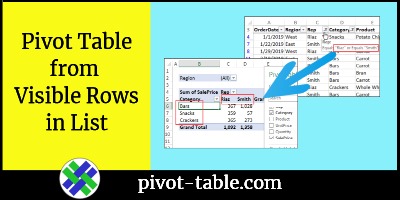
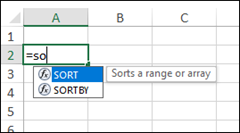
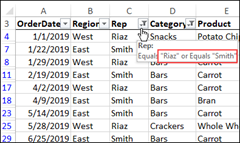
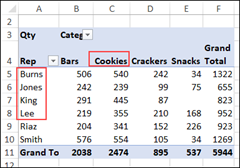
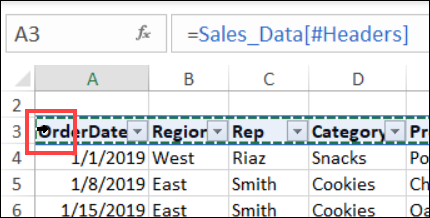

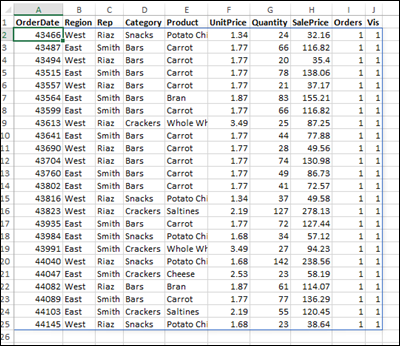
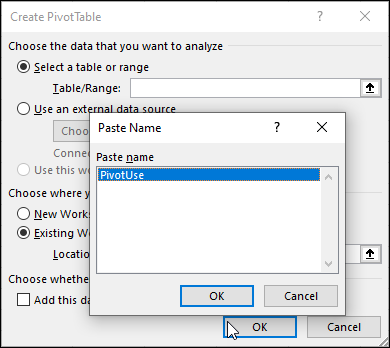
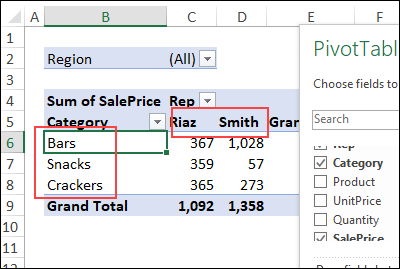
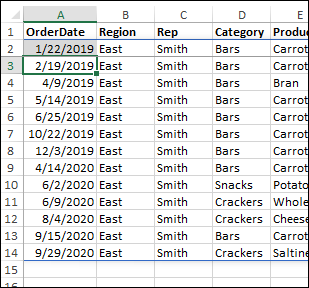
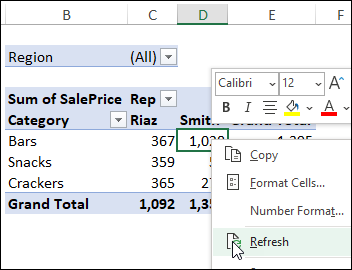
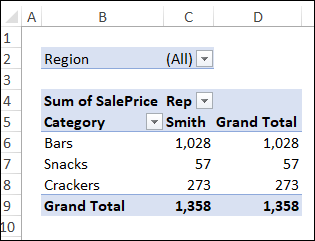
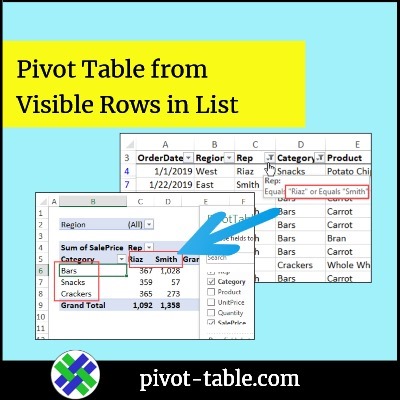
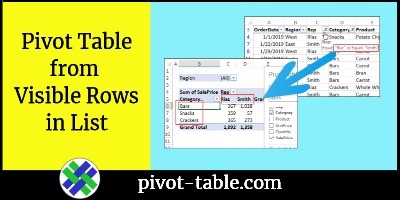
Hi Debra,
I’ve been playing around with the new Unique and filtering/sorting functions. I didn’t realize until reading this post that you can have a formula that refers to an entire table, and that the results will expand and contract along with the source table!
What brought me to this post was an attempt to have a pivot table that’s filtered to a sample of items, e.g., only pick the first three instances of each item in a field. I would use this to send some example data to a colleague when they don’t need to see every row in the pivot table. Does that make sense, and if so, do you of a way to do it directly in the pivot table?
What I’ve done for now is to COUNTIF each item in the source data and then filter that count field to 1,2, and 3.This is slowish 200,000-plus rows
Thanks, Doug, and I couldn’t come up with a better spill function solution.
Could you use a macro to run an advanced filter instead, and base the pivot table on the extract?
That way, you’d just need one formula, in the criteria area, instead of every row in the source data
Thanks Debra, I’ll try that. Stay well!